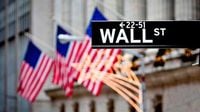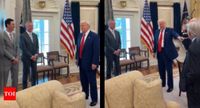On Wednesday morning, April 9, 2025, U.S. markets experienced notable fluctuations until former President Donald Trump made a significant announcement on Truth Social, advising his followers that it was an optimal time to purchase stocks. This tweet seemed to set off a chain reaction in the financial markets. Approximately four hours later, Trump announced a 90-day suspension of tariffs, which led to significant market gains across various sectors.
Criticism soon followed after White House aide Margo Martin shared a video where Trump referenced substantial financial gains made by executives, specifically citing figures of $2.5 billion and $900 million. This revelation raised eyebrows, as many questioned the implications of such statements. A social media user, identified as Zubare Khan and claiming to be a multi-asset trader on X, criticized what appeared to be market manipulation. He pointed out a concerning pattern of presidential tweets followed by policy changes that seemed to benefit specific individuals financially. "Imagine a president tweeting, ‘This is the right time to buy,’ then pausing the tariffs, and later happily saying how his friends made $2.5 billion and $900 million. Real PUMP AND DUMP," Khan remarked, highlighting the potential ethical issues surrounding Trump's statements.
The immediate impact of Trump's announcement was evident, as the S&P 500 surged by 9.5%, recovering nearly $4 trillion in market value. However, former White House ethics lawyer Richard Painter expressed serious concerns to the Associated Press about potential violations of securities laws regarding insider trading. Painter's apprehensions were echoed by many financial analysts who scrutinized the timing of Trump's tariff pause.
When asked about the timing of his decision, Trump offered an imprecise response, stating that the decision was made that very morning after considering it for several days. White House spokesperson Kush Desai defended the post, arguing that it was the President's responsibility to provide economic reassurance during uncertain times. However, the timing of the tweet, which coincidentally matched the stock ticker for Trump Media and Technology Group, raised further suspicions. Shares of the company increased by 22.67%, despite reporting a £400 million loss the previous year. Trump's 53% stake in the company, managed by his son Donald Trump Jr., gained £415 million in value following the announcement.
Meanwhile, shares of Tesla also experienced significant growth, adding £20 billion to Elon Musk's wealth. This surge followed recent endorsements from Trump and his commerce secretary, further intertwining the lines between political statements and market performance.
However, the euphoria in the markets did not last long. On Thursday, April 10, 2025, the Dow Jones Industrial Average and other major stock indexes slid, despite a surprisingly cool inflation report. This pullback came as investors began to reassess the implications of Trump's tariff suspension. Notably, three major players in the market, including Nvidia (NVDA) and Tesla (TSLA), along with Nvidia partner Taiwan Semiconductor, saw their stock prices decline significantly.
The market's reaction to Trump's announcements has raised questions about the sustainability of such gains, especially in light of the recent inflation data. As the financial community awaits further economic indicators, the volatility of the market serves as a reminder of the intricate relationship between political actions and market dynamics.
While Trump's tariff suspension initially sparked optimism and significant market gains, the subsequent pullback highlights the uncertainty that often accompanies rapid policy changes. Investors are now left to ponder the long-term effects of these developments on the market and the broader economy.
As the situation continues to evolve, analysts will be closely monitoring the markets for signs of stabilization or further volatility. The interplay between political maneuvers and market movements will undoubtedly remain a focal point for investors and policymakers alike in the coming weeks.





